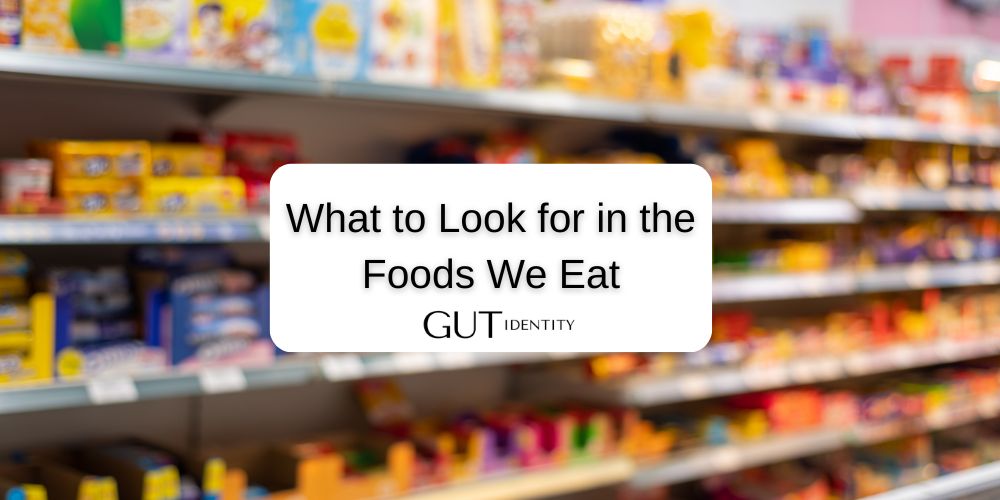
Over the past 5 years, I’ve done a lot of research into the foods I was eating. This was due to coeliac disease which forced me into having to learn to read labels. What I found was not great so I adopted a whole foods diet (eating real food), to avoid all the crap that’s being added to our food.
What I also discovered was that we can no longer rely on the regulatory agencies to keep us ‘safe’ from the harmful chemicals companies are adding to foods. To put it really bluntly, we are on our own, making doing our own research crucial.
These are the top things that I look for in what I eat. I don’t eat hardly any packaged processed foods, but I wanted to share the information in case someone else wanted to do the same.
Check out the following graphic that breaks it down:
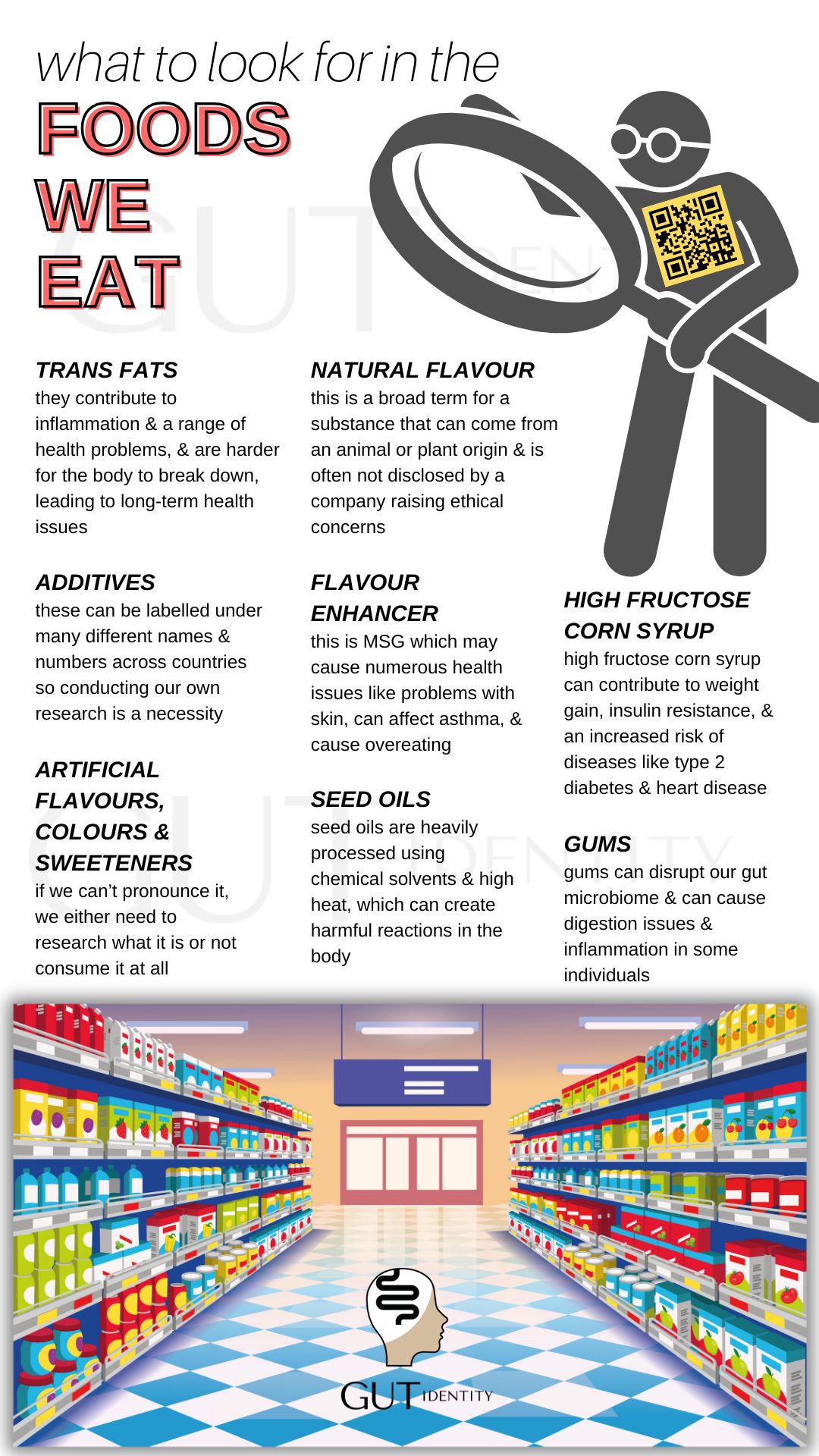
Let's start with trans fats
Trans fats are harmful because they increase the risk of heart disease, strokes, and other cardiovascular issues. They also promote inflammation, which is linked to conditions like arthritis and diabetes, and can contribute to insulin resistance, raising the risk of type 2 diabetes. Additionally, trans fats are often found in highly processed and fried foods, which contribute to weight gain and obesity.
To avoid trans fats, it’s best to check nutrition labels for “partially hydrogenated oils,” and cut these nasty fats out altogether. I don’t believe we should just limit toxic stuff like this. Elimination is the best option in my opinion.
Check processed foods for Natural Flavour - just what on earth is this stuff????

There is an ingredient that seems to be popping up in almost all processed foods I look at. It’s called ‘Natural Flavour’. It’s like it just magically appeared a few years ago and I bet if you go and look in your cupboards and fridges, you’ll find it in almost everything processed and packaged.
So, just what is this mysterious ingredient and what can we do about it if we don’t want to be consuming it? Natural flavour is a broad term for flavouring ingredients derived from natural sources like fruits, vegetables, herbs, spices, meat, or dairy. So basically, it could be from anything.
I’ve been curious about it for a while because as far as I was aware, ‘natural flavour’ could be anything and I have no way of checking unless I email the company. Even then, they still don’t have to disclose to me what it is. This seems very unethical to me and not transparent. It also has implications for vegetarians, vegans, and even some religions because if the natural flavour is derived from a meat source, it has the potential to go against a person’s beliefs.
The only way for me to take a stand against this kind of situation is to vote with my dollar. I look at everything I buy and if I feel that if a company isn’t transparent about its labelling, what else is a company like this also doing? I don’t know! Therefore, I can’t trust them, unfortunately.
Read more about ‘natural flavour’ in this ARTICLE.
If you can, ring a company to find out where they source their natural flavour or if they can give you any information about what the source is.
Check packaged and processed foods for additives
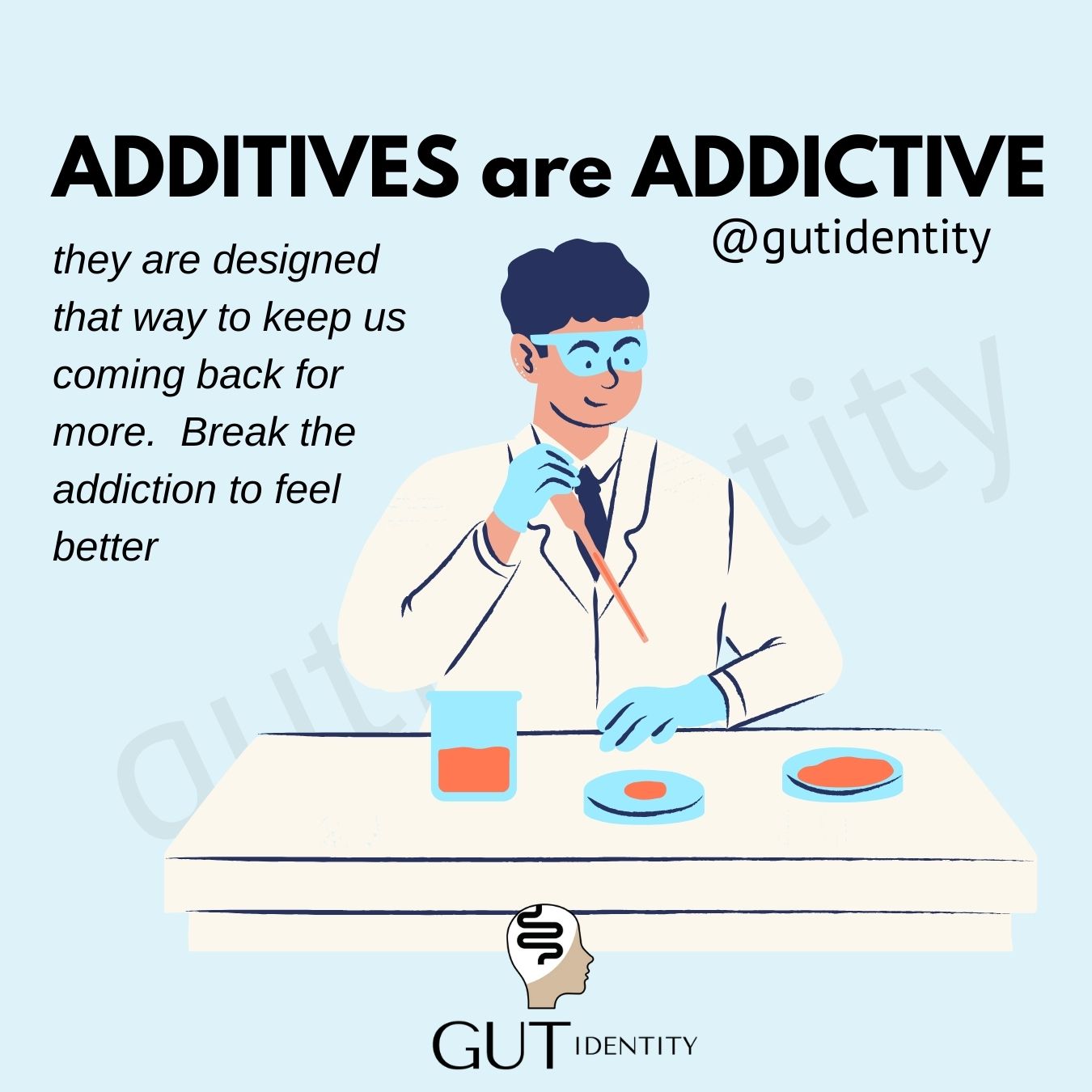
When I think about what’s going into my food, the easiest way for me to ‘see’ is to visualise what and who is making it. When I really thought about it, was I visualising a person who looked like a chef baking and cooking in a big factory kitchen or someone in a white coat in a lab creating chemical compounds specifically designed to create and feed addiction? Research what a ‘flavour chemist’ is!
When I realised it was the person in the white coat, the way I viewed my food and its creation changed completely. What was I eating? Why would someone want to create food that feeds disease and want me to be addicted to it? When you start to follow the money, things become much clearer.
It’s important to note that I still get tripped up so have to be constantly checking the food I’m eating.
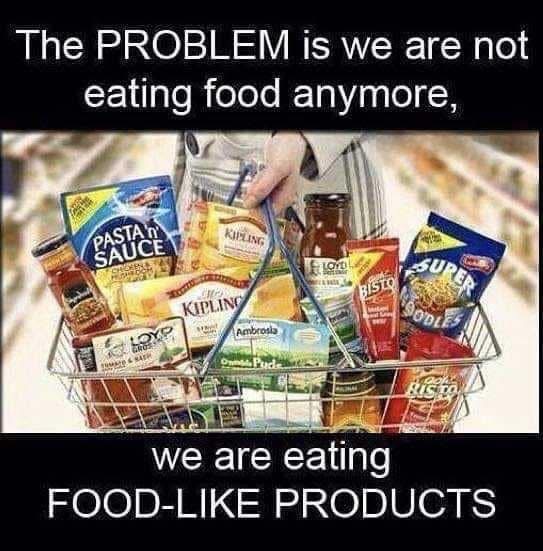
IMAGE source – unknown
Additives in food, like preservatives, E numbers and emulsifiers, are not good. But don’t take my word for it. We have to do our own research. If it’s going down your throat, find out what it is.
Many additives are highly processed and can contribute to inflammation, digestive issues, and long-term health risks. Some, like artificial colours and sweeteners, have been linked to ADHD symptoms, allergies, and metabolic disruptions. Others, like certain preservatives, can negatively impact gut health or have potential links to chronic diseases. I know this first hand through breaking my gut and developing coeliac disease.
Emulsifiers can have a harmful effect on our gut microbiome so avoiding them is the best option.
Doing our own research in this area is critical. Don’t rely on what the regulatory agencies are doing because they haven’t done a very good job so far. If they had, we would all be a picture of health. We have put too much faith in governing bodies to do the research for us and where has that got us???? Despite leaps in modern medicine, we are sicker as a species than ever before. WHY?
We’ve been hoodwinked.
The 'seed oil' rabbit hole - eeeeeeeekkkkkkk
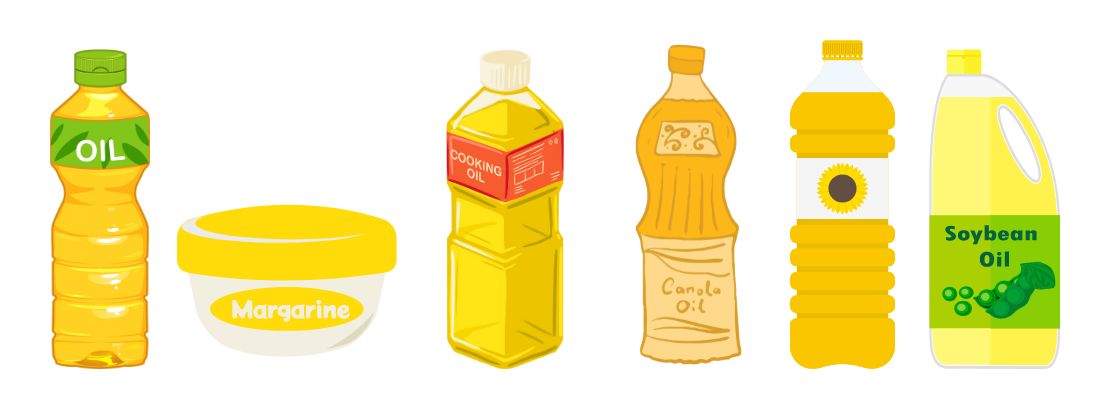
The following information was taken directly from ChatGpt. Check it out. I guess AI is good for something eh!
Seed oils, such as cottonseed, soybean, corn, canola, and sunflower oil, were originally used for industrial purposes before becoming a common ingredient in food. Their initial applications included:
- Lubricants for Machinery – Early industries used seed oils as lubricants for mechanical equipment, including engines and factory machines.
- Soap and Detergent Production – Oils like cottonseed and soybean oil were key ingredients in soap-making.
- Lamp Fuel – Some seed oils were used in oil lamps before petroleum-based fuels became widespread.
- Paints and Varnishes – Linseed oil (from flax seeds) was commonly used in paints, varnishes, and coatings due to its drying properties.
- Animal Feed – The by-products of seed oil extraction were often used to feed livestock.
- Industrial Chemicals and Plastics – Seed oils were processed into various industrial products, including bio-based plastics and solvents.
In the late 19th and early 20th centuries, food manufacturers found ways to refine and hydrogenate these oils, making them shelf-stable and cheap alternatives to traditional fats like butter and lard. This led to their widespread use in processed foods, margarine, and fast food. However, concerns over the health effects of highly processed seed oils, particularly their omega-6 fatty acid content and potential for inflammation, have fuelled debates about their role in modern diets.
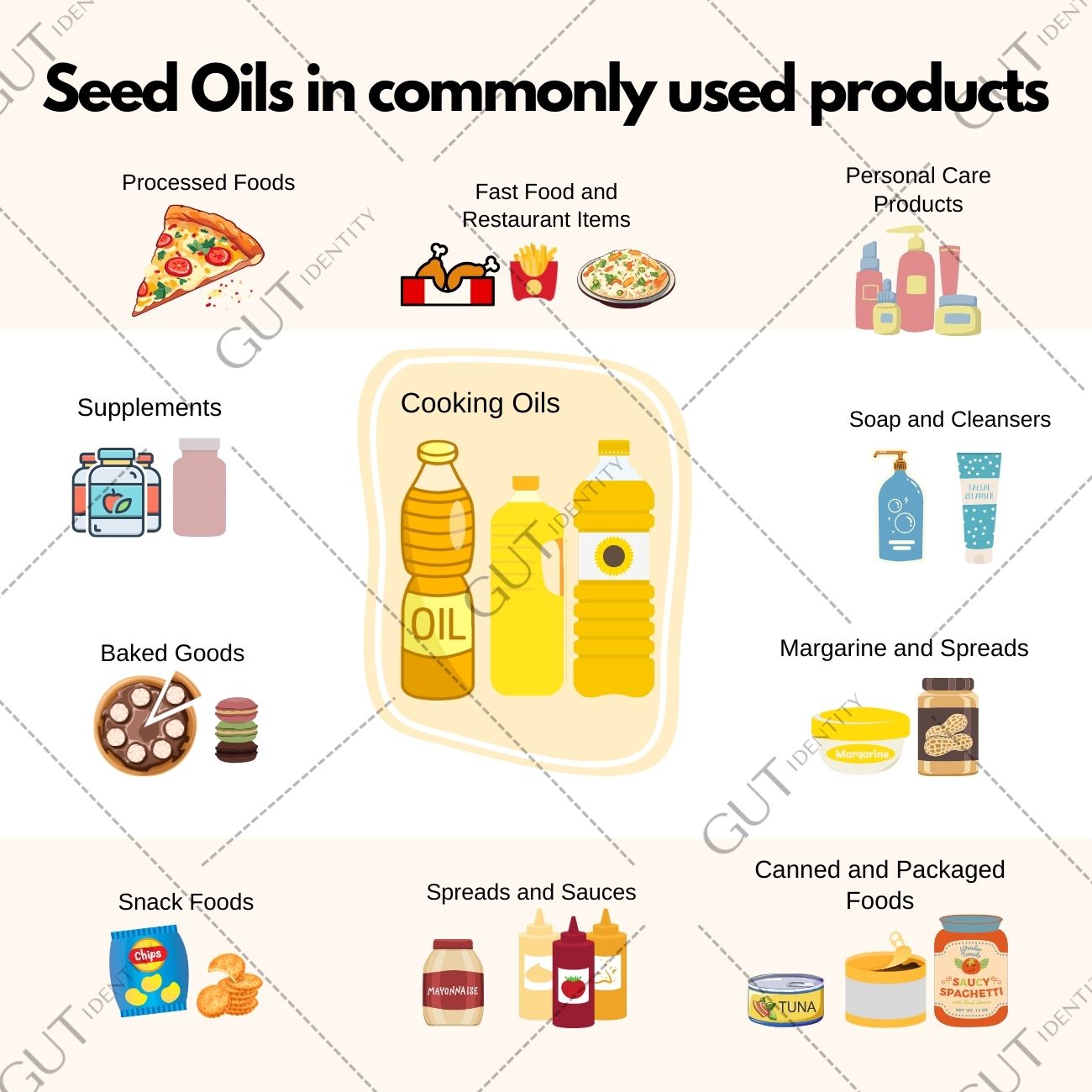
Learn to check EVERYTHING
Seed oils, like vegetable, canola, corn, and sunflower oil, can be bad for health because they can lead to inflammation, which is linked to chronic diseases like heart disease, obesity, and diabetes. Many seed oils are also heavily processed using chemical solvents and high heat, which can create harmful by products like trans fats. Choosing healthier fats, like olive oil, avocado oil, or butter in moderation, is a better option for overall health.
Always check labels for substances that may be under different names
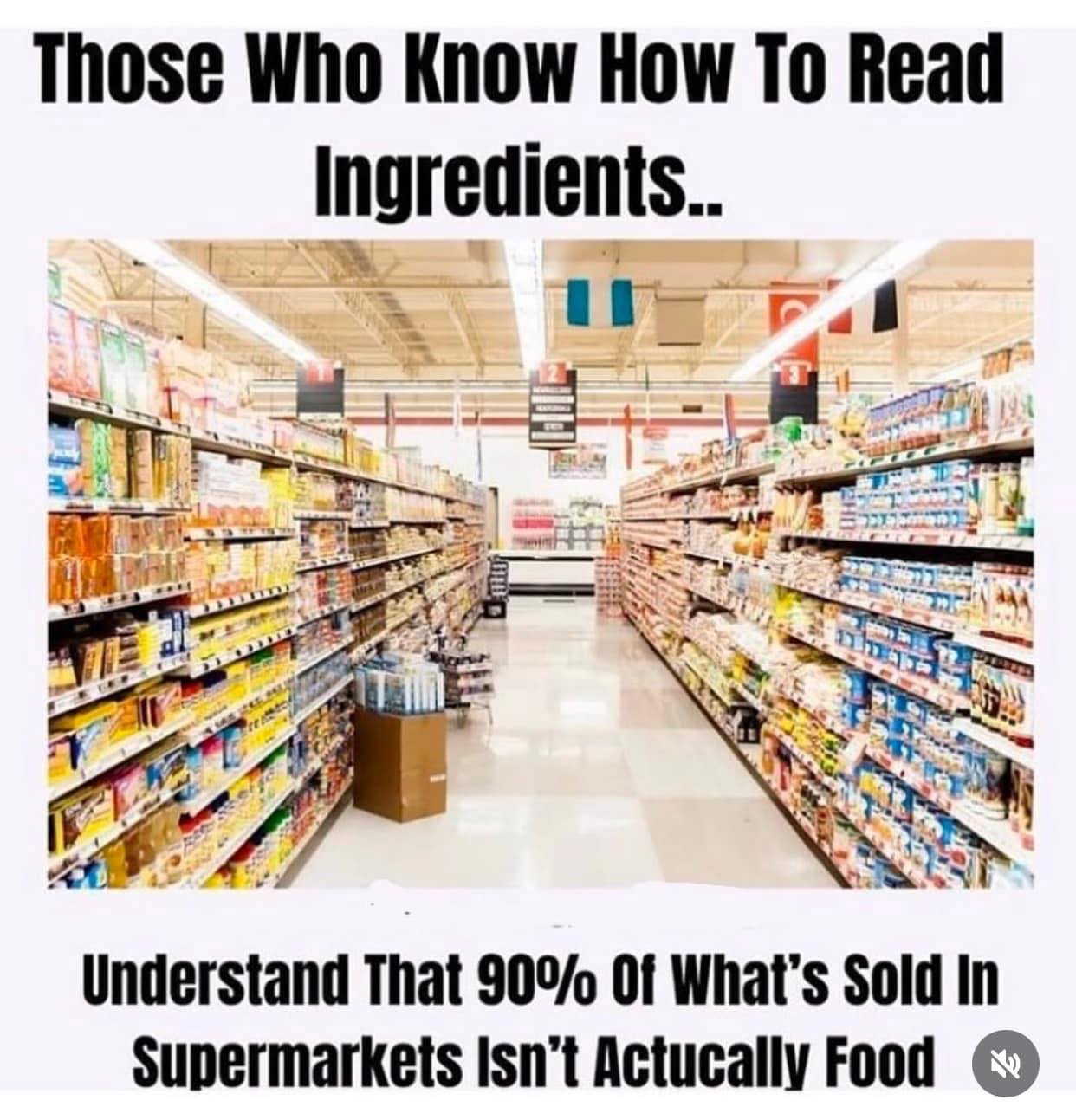
SOURCE – unknown but thanks
I was with someone recently who was telling me about getting migraines and they think it was from eating MSG. I told them that it can be labelled under different names and numbers.
They asked me to check a pot of noodles that they had been eating to see if there was anything in it I could see related to MSG. We had just had a conversation about how it’s labelled under different names and numbers. And lo and behold, it had MSG in it labelled under “flavour enhancer”. She had no clue but wondered why she got such a bad migraine after it.
It’s so important to read the ingredients labels but I had to ask her for a magnifying glass because they’re so tiny and I couldn’t read it myself. There were also other ingredients on the packet that I couldn’t even pronounce and I’m a teacher. ![]()
![]()
![]()
If we know what we’re eating, we can clear up health complaints pretty quickly by removing these things from our diet. MSG causes problems with skin, respiratory symptoms like asthma, migraines, and is also not good for people with ADHD (research is still ongoing in this area). But if you suffer from any of those conditions, removing it from your diet will help you immensely but you need to know what to look for.

MSG (monosodium glutamate) is a flavour enhancer often used in processed foods and restaurant meals. Some people report symptoms like headaches, nausea, or fatigue after consuming it, often called “MSG sensitivity.” MSG can also trigger cravings and overeating by overstimulating taste receptors. Additionally, since it’s commonly found in highly processed foods, excessive consumption may contribute to poor diet choices and inflammation.
Look out for these numbers and names on labels to find hidden MSG
- 620 L -glutamic acid
- 621 Monosodium glutamate, L-
- 622 Monopotassium glutamate, L-
- 623 Calcium glutamate, Di-L-
- 624 Monoammonium glutamate, L-
- 625 Magnesium glutamate, Di-L-
- 627 Disodium guanylate, 5’-
- 631 Disodium inosinate, 5’-
- 635 Disodium ribonucleotides, 5’-
SOURCE:
Monosodium glutamate (MSG)
Keep a look out for high fructose corn syrup and its multiple different names
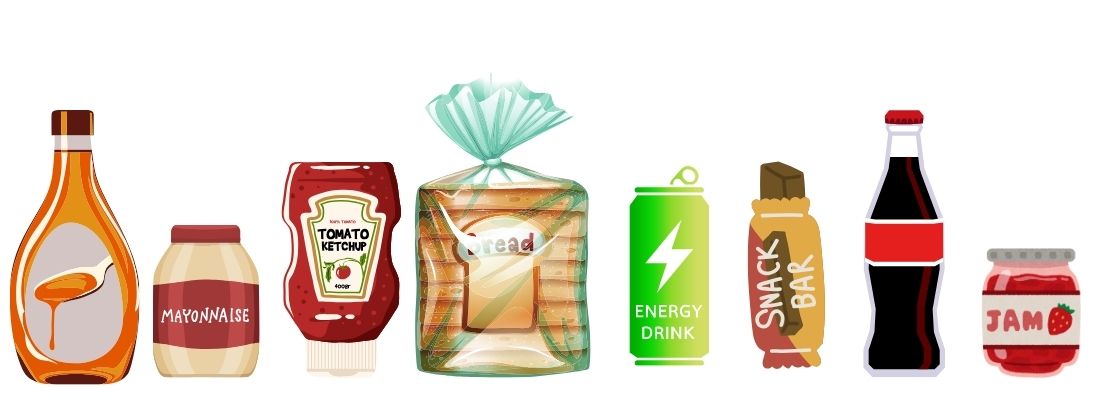
I used to live on energy drinks so I would’ve been consuming so much high fructose corn syrup (HFCS) that it was no wonder my gut lining broke. It’s a tricky little ingredient because it can be labelled under names.
HFCS is bad because it can contribute to weight gain and health problems. Unlike normal sugar, HFCS is processed differently in the body, with excess fructose going straight to the liver, where it can turn into fat. It’s also found in many processed foods and sugary drinks like energy drinks, making it easy to overconsume, leading to blood sugar spikes, inflammation, and cravings. For me personally, I don’t consume even small amounts of this after researching how bad it was.
HFCS is often labelled under different names making it trickier to detect. Here are some other names for HFCS you might find on food and drink packaging:
Common Names for HFCS:
- High Fructose Corn Syrup (HFCS) – The most common and direct name.
- Corn Syrup – Sometimes used interchangeably, though corn syrup may not always be high in fructose.
- Corn Sugar – A misleading term used in marketing.
- Glucose-Fructose Syrup – Common in Canada and Europe.
- Isoglucose – Another term used in European food labelling.
- Maize Syrup – Alternative name, especially in the UK.
- Fructose-Glucose Syrup – Similar to glucose-fructose syrup but with different ratios.
Variations of HFCS with Different Fructose Content:
- HFCS-42 – 42% fructose, used in processed foods and baked goods.
- HFCS-55 – 55% fructose, commonly found in soft drinks.
- HFCS-90 – 90% fructose, used in special applications and sometimes blended with other syrups.
The easiest way to avoid HFCS is to avoid processed food. This is what I did. I can’t be bothered reading labels and the moment I stopped eating and drinking this crap, my brain started to calm down.
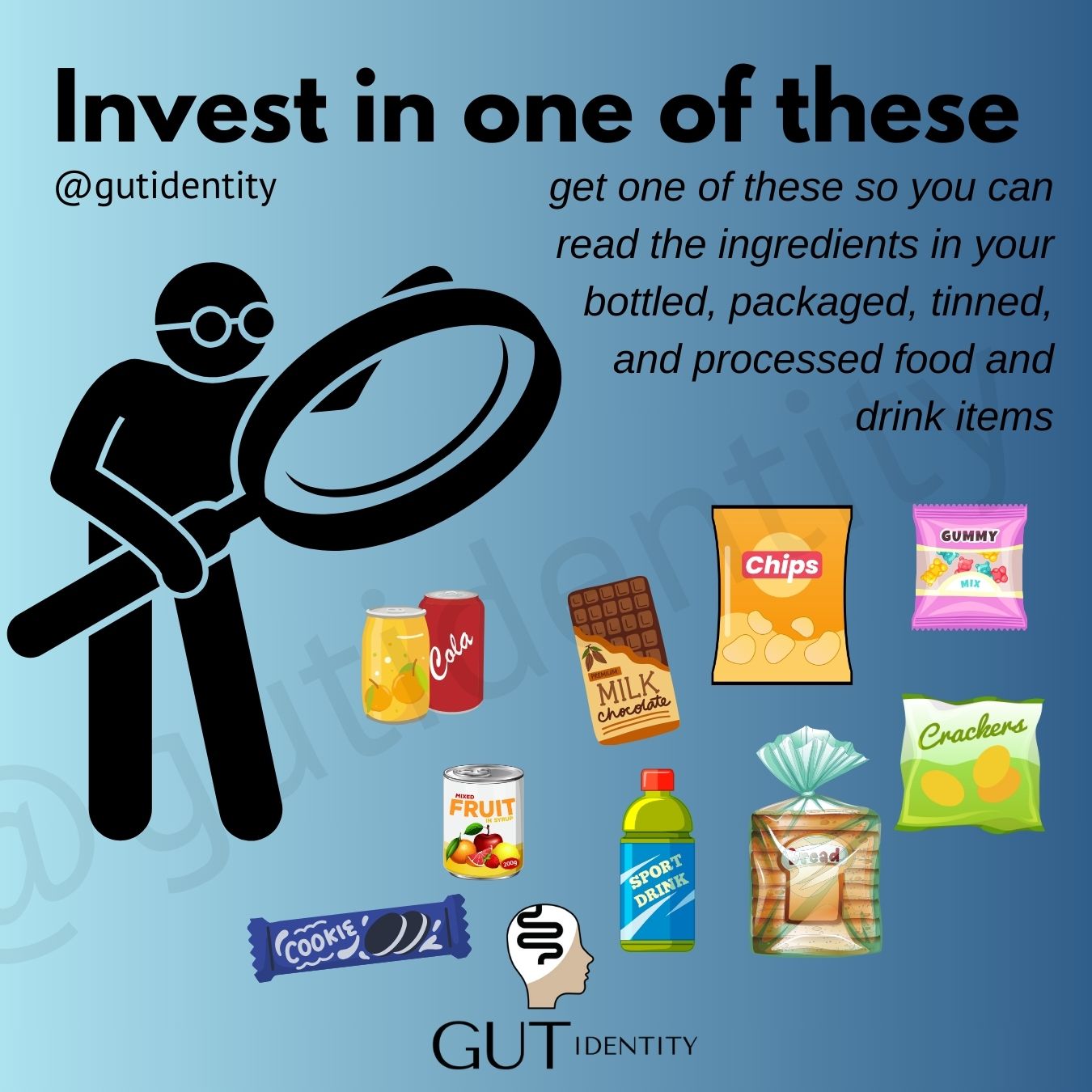
Avoiding high fructose corn syrup (HFCS) can be challenging since it’s hidden in many processed foods, but here are some practical tips to help cut it out of your diet:
1. Read Ingredient Labels Carefully
- Look for “high fructose corn syrup,” “glucose-fructose syrup,” or similar names
- Use a magnifying glass to read labels if the text is too small
2. Choose Whole, Unprocessed Foods
- Stick to fresh fruits, vegetables, meats rather than packaged and processed foods
- Make homemade versions of sauces, dressings, and baked goods so you know what’s going into your food (I found this easy once you get the hang of it)
- Eat simply – don’t overcomplicate meals as this can lead to overwhelm
3. Avoid Sugary Drinks
- Fizzy drinks, energy drinks, fruit-flavoured beverages, and sweetened iced teas often contain HFCS
- Replace them with water, herbal tea, sparkling water, or homemade fruit-infused water
4. Watch out for “Healthy” and Low-Fat Foods
- Many low-fat yogurts, snack bars, protein bars, and salad dressings use HFCS to enhance sweetness and flavour
- Opt for unsweetened or naturally sweetened alternatives
5. Swap Processed Snacks for Natural Alternatives
- Instead of cookies, crackers, and breakfast cereals with added HFCS, try:
- Fresh fruit (apples, berries, bananas)
- Plain yogurt with quality honey
6. Watch Out for Bread, Condiments, and Canned Goods
- HFCS is often found in white bread, tomato sauce, BBQ sauce, jams, and canned fruits
- Look for organic or “no added sugar” versions or make our own at home
7. Choose Natural Sweeteners
- If we need sweetness, go for raw honey or maple syrup – avoid ‘favoured syrups’ masquerading as natural syrups
8. Eat Out Less Often
- Many fast food chains and restaurants use HFCS in their sauces, dressings, and even burger buns
- Cooking at home helps us control our ingredients
Look out for artificial flavours, colours and sweeteners

Artificial flavours, colours, and sweeteners are things we need to be on the look out for because they are highly processed and may have negative effects on our body over time.
Artificial flavours are made from synthetic chemicals to mimic natural tastes, but they don’t offer any real nutritional benefits and may contribute to cravings for processed foods.
Artificial colours have been linked to hyperactivity in children and potential allergic reactions, and some studies suggest they may have long-term health risks.
Artificial sweeteners (like aspartame, sucralose, and saccharin) can disrupt gut health, increase sugar cravings, and may even interfere with metabolism, leading to weight gain instead of weight loss.
While small amounts might not cause immediate harm, if we consume lots of processed food where these things lurk, there’s no way of adding up just how much we consume on a daily basis. And then multiply this by the week, month, then over the years.
Finding accurate information on how artificial sweeteners affect health is really hard due to biases, financial or commercial conflicts of interests, and the fact the health industry has been captured and corrupted on so many levels. The majority of articles I can find on PubMed state that research still needs to be completed in this area which has been the case for years. NOTHING CHANGES in case you haven’t already picked up on this! This makes finding peer-reviewed research that is trustworthy extra hard these days. Due to this, and the fact that I’m not a Doctor, do your own research and listen to your body.
If you have a physical complaint in your body, it’s a warning sign that something is off balance. Only you know your own body so don’t wait until it manifests into disease, do something about it now.
Check labels for food gums
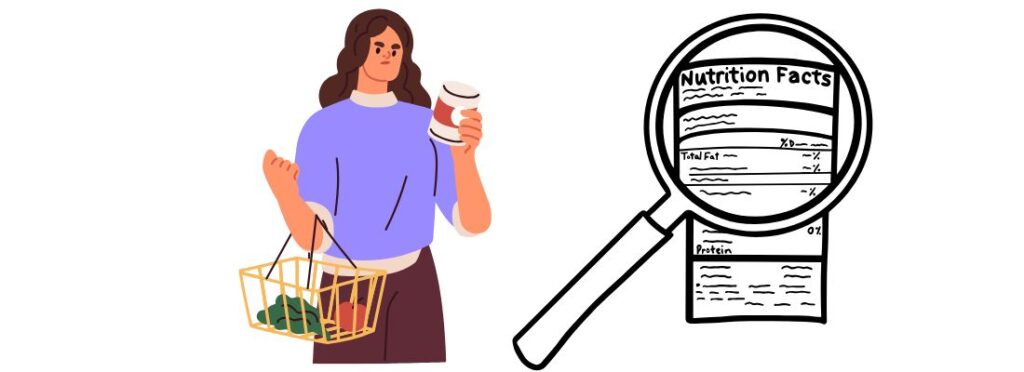
I don’t know much about food gums because I don’t eat foods that contain them but from what I do know, is they can cause some people to have digestive issues like bloating, gas, or discomfort. And eating them, could cause the gut harm by creating inflammation which could lead to other issues further down the line.
Food gums, like xanthan gum are used to thicken and stabilise processed foods, but they can have downsides. Certain gums, like guar gum, have also been linked to inflammation and gut irritation in some studies.
Here’s what I found on Guar gum:
Guar gum increased susceptibility to colitis
Guar gum-induced exacerbation of colitis is gut microbiota dependent
REFERENCE:
Dietary fiber guar gum-induced shift in gut microbiota metabolism and intestinal immune activity enhances susceptibility to colonic inflammation
You may find Guar gum in the following products:
1. Processed & Packaged Foods
✔ Dairy Products – Ice cream, yogurt, cream cheese, and some plant-based milk (almond, coconut, soy).
✔ Baked Goods – Gluten-free bread, cakes, cookies, and tortillas.
✔ Sauces & Dressings – Salad dressings, ketchup, BBQ sauce, and mayonnaise.
✔ Soups & Canned Goods – Canned soups, stews, and broths to improve texture.
✔ Beverages – Protein shakes, fruit juices, and meal replacement drinks.
✔ Frozen Foods – Ready-made meals, frozen desserts, and pizza dough.
2. Gluten-Free & Vegan Products
✔ Gluten-Free Bread & Pasta – Used to improve elasticity and texture.
✔ Plant-Based Dairy Substitutes – Found in almond, soy, oat, and coconut milk for creaminess.
3. Pharmaceuticals & Personal Care Products
✔ Medications & Supplements – Some tablets and fibre supplements use guar gum as a binder.
✔ Cosmetics & Lotions – Found in shampoos, conditioners, creams, and toothpaste as a thickening agent.
Take note that it could be in gluten-free products so while we think we might be doing the right thing by avoiding gluten, we are actually still harming the gut, and our brain, but in a different way.

The way forward
For me, the only way to avoid nasty chemicals, gums, emulsifiers, and artificial stuff was to adopt a whole foods diet. This means I eat on a very small amount of processed foods. I eat around 95% whole foods and 5% processed. I also eat out occasionally so only have seed oils or similar very rarely.
This is a good way to almost completely monitor what I’m eating. I’m the healthiest I’ve ever been in my life and feel great because of it. I would never go back to eating the way I was after learning what I’ve learned.
Check out the following post about eating whole foods:
Related Post
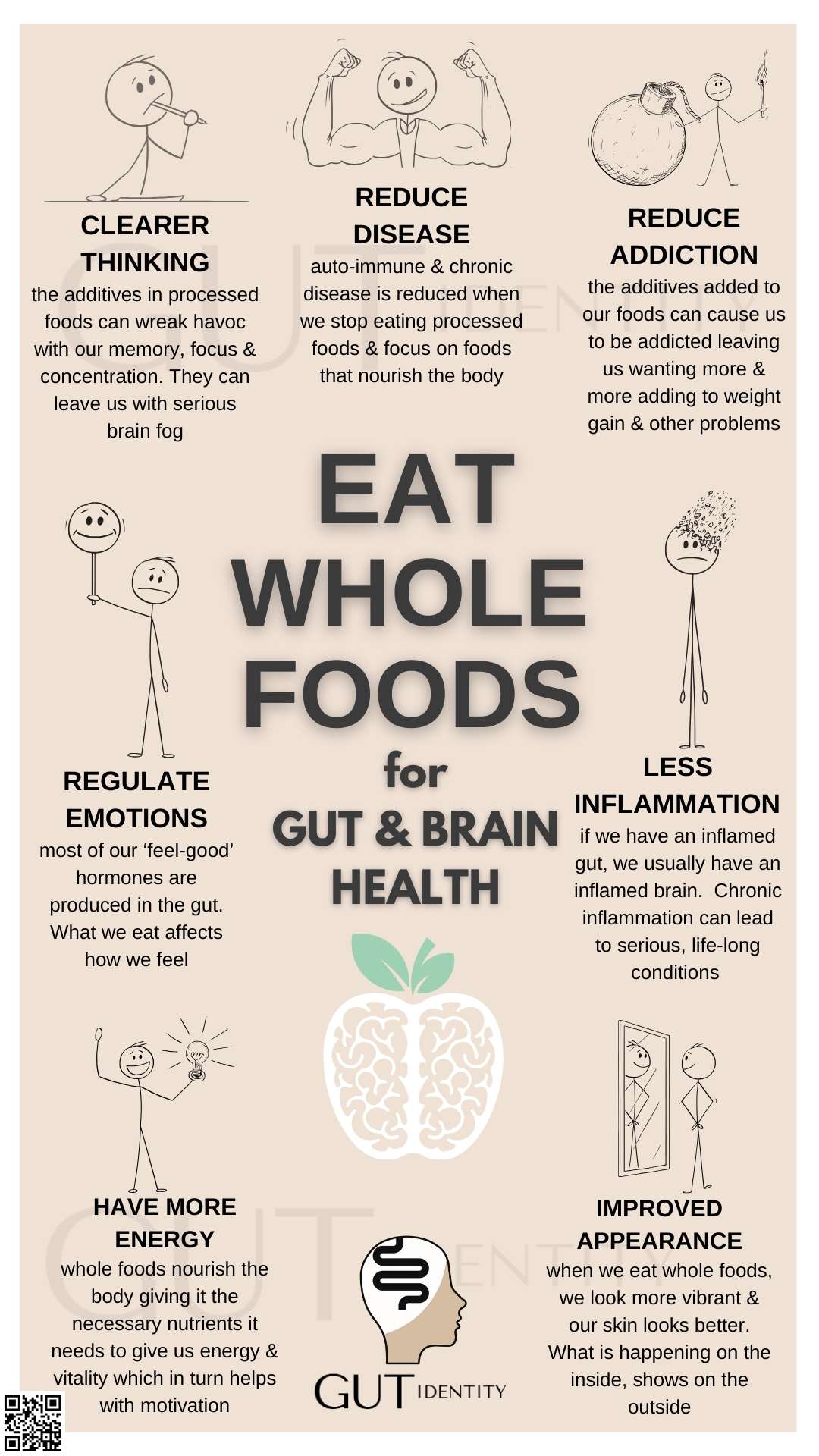
Bottom line
This is such a massive subject that requires so much research because in just one food item, there can be 10+ ingredients that might cause different reactions within our body. The only way to stop the harm to our body is to avoid them. Eat whole foods that don’t require checking. And, don’t take my word for it. We have to get into the habit of doing our own checking because at the end of the day, it’s our own body and we need to be responsible for it.




